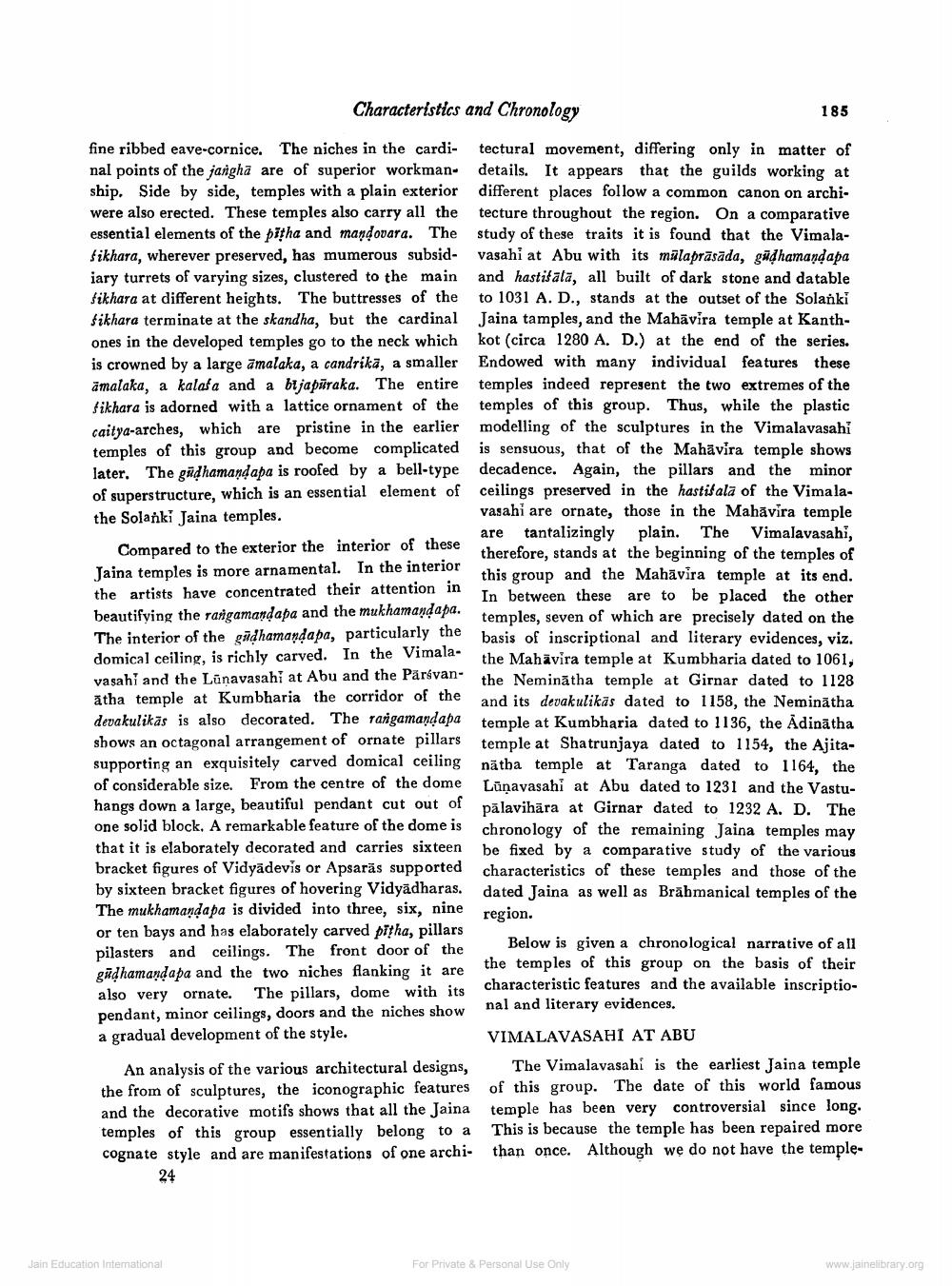________________
Characteristics and Chronology
185
fine ribbed eave-cornice. The niches in the cardi- tectural movement, differing only in matter of nal points of the jangha are of superior workman- details. It appears that the guilds working at ship. Side by side, temples with a plain exterior different places follow a common canon on archiwere also erected. These temples also carry all the tecture throughout the region. On a comparative essential elements of the pitha and mandovara. The study of these traits it is found that the Vimalafikhara, wherever preserved, has mumerous subsid- vasahi at Abu with its mālaprāsāda, gādhamandapa jary turrets of varying sizes, clustered to the main and hastifala, all built of dark stone and datable fikhara at different heights. The buttresses of the to 1031 A. D., stands at the outset of the Solanki fikhara terminate at the skandha, but the cardinal Jaina tamples, and the Mahāvira temple at Kanthones in the developed temples go to the neck which kot (circa 1280 A. D.) at the end of the series. is crowned by a large amalaka, a candrika, a smaller Endowed with many individual features these āmalaka, a kalaša and a bljapūraka. The entire temples indeed represent the two extremes of the fikhara is adorned with a lattice ornament of the temples of this group. Thus, while the plastic caitya-arches, which are pristine in the earlier modelling of the sculptures in the Vimalavasah temples of this group and become complicated is sensuous, that of the Mahavira temple shows later. The gūdhamandapa is roofed by a bell-type decadence. Again, the pillars and the minor of superstructure, which is an essential element of ceilings preserved in the hastif ala of the Vimala. the Solanki Jaina temples.
vasahi are ornate, those in the Mahāvira temple
are tantalizingly plain. The Vimalavasahi, Compared to the exterior the interior of these
therefore, stands at the beginning of the temples of Jaina temples is more arnamental. In the interior
this group and the Mahāvira temple at its end. the artists have concentrated their attention in
In between these are to be placed the other beautifying the rangamandapa and the mukhamandapa.
temples, seven of which are precisely dated on the The interior of the gadhamandapa, particularly the basis of inscriptional and literary evidences, viz. domical ceiling, is richly carved. In the Vimala
the Mahävira temple at Kumbharia dated to 1061, vasahi and the Lūnavasahi at Abu and the Parávan
the Neminātha temple at Girnar dated to 1128 atha temple at Kumbharia the corridor of the and its devakulikās dated to 1158, the Neminātha devakulikās is also decorated. The rarigamandapa temple at Kumbharia dated to 1136, the Adinātha shows an octagonal arrangement of ornate pillars temple at Shatrunjaya dated to 1154, the AjitaSupporting an exquisitely carved domical ceiling nätba temple at Taranga dated to 1164, the of considerable size. From the centre of the dome Lūnayasahi at Abu dated to 1231 and the Vastuhange down a large, beautiful pendant cut out of palavihära at Girnar dated to 1232 A. D. The one solid block. A remarkable feature of the dome is chronology of the remaining Jaina temples may that it is elaborately decorated and carries sixteen be fixed by a comparative study of the various bracket figures of Vidyadevis or Apsarās supported characteristics of these temples and those of the by sixteen bracket figures of hovering Vidyadharas. dated Jaina as well as Brahmanical temples of the The mukhamanda pa is divided into three, six, nine region. or ten bays and has elaborately carved pitha, pillars pilasters and ceilings. The front door of the
Below is given a chronological narrative of all gadhamandapa and the two niches flanking it are the temples of this group on the basis of their also very ornate. The pillars, dome with its characteristic features and the available inscriptiopendant, minor ceilings, doors and the niches show nal and literary evidences. a gradual development of the style.
VIMALAVASAHI AT ABU An analysis of the various architectural designs, The Vimalavasahi is the earliest Jaina temple the from of sculptures, the iconographic features of this group. The date of this world famous and the decorative motifs shows that all the Jaina temple has been very controversial since long. temples of this group essentially belong to a This is because the temple has been repaired more cognate style and are manifestations of one archi- than once. Although we do not have the temple
24
Jain Education International
For Private & Personal use only
www.jainelibrary.org




